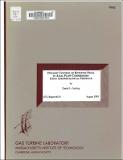| dc.contributor.author | Gysling, Daniel L. | en_US |
| dc.contributor.other | Massachusetts Institute of Technology. Gas Turbine Laboratory | en_US |
| dc.date.accessioned | 2016-10-06T21:22:27Z | |
| dc.date.available | 2016-10-06T21:22:27Z | |
| dc.date.issued | 1993 | en_US |
| dc.identifier.uri | http://hdl.handle.net/1721.1/104755 | |
| dc.description | August 1993 | en_US |
| dc.description | Includes bibliographical references (pages 250-252) | en_US |
| dc.description.abstract | Dynamic control of rotating stall in an axial flow compressor has been implemented using aeromechanical feedback. The control strategy developed used an array of wall jets upstream of a single stage compressor which were regulated by locally reacting reed valves. These reed valves responded to pressure perturbations in the flow that were associated with small amplitude perturbations that precede rotating stall. The control strategy was designed such that the combined system of compressor plus the reed valve controller was stable in previously unstable operating conditions. A 10% decrease in the stalling flow coefficient was achieved using this dynamic feedback control strategy, and the stable flow range was extended with no noticeable change in the steady state performance of the compression system. | en_US |
| dc.description.abstract | The experimental demonstration is the first use of aeromechanical feedback to extend the stable operating range of an axial flow compressor, as well as the first use of locally reacting feedback and dynamic compensation techniques to stabilize rotating stall in an axial flow compressor. The design of the experiment was based on a two-dimensional model of the rotating stall dynamics which incorporated the effect of aeromechanical feedback. The physical mechanism responsible for rotating stall in axial flow compressors was examined with focus on the role of dynamic feedback in stabilizing compression system instability. The effectiveness of the aeromechanical control strategy was predicted, and experimentally demonstrated, to be a function of a set of non-dimensional control parameters that determine the interaction of the control strategy and the rotating stall dynamics. | en_US |
| dc.description.abstract | Predictions based on linear stability analyses and non-linear numerical simulations agreed qualitatively with the steady state and time resolved experimental data. During the experimental investigations, large amplitude, one-dimensional acoustic oscillations were observed in the compression system with aeromechanical feedback stabilization. Based on these observations, the role of the compression system parameters in the acoustic oscillations was examined analytically and a method was developed to reduce these oscillations. The mechanism responsible for the generation of self-excited acoustic oscillations, and the implications for dynamic control of compression system instabilities was also examined. | en_US |
| dc.format.extent | 347 pages | en_US |
| dc.publisher | Cambridge, Mass. : Gas Turbine Laboratory, Massachusetts Institute of Technology, [1993] | en_US |
| dc.relation.ispartofseries | GTL report #219 | en_US |
| dc.subject.lcc | TJ990 .G97 1993 | en_US |
| dc.subject.lcc | TJ778.M41 G24 no.219 | en_US |
| dc.subject.lcsh | Axial flow compressors -- Aerodynamics | en_US |
| dc.subject.lcsh | Stalling (Aerodynamics) | en_US |
| dc.title | Dynamic control of rotating stall in axial flow compressors using aeromechanical feedback | en_US |
| dc.type | Technical Report | en_US |
| dc.identifier.oclc | 32009669 | en_US |
